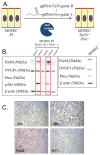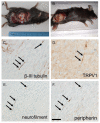Intra-Tumoral Nerve-Tracing in a Novel Syngeneic Model of High-Grade Serous Ovarian Carcinoma
- PMID: 34944001
- PMCID: PMC8699855
- DOI: 10.3390/cells10123491
Intra-Tumoral Nerve-Tracing in a Novel Syngeneic Model of High-Grade Serous Ovarian Carcinoma
Abstract
Dense tumor innervation is associated with enhanced cancer progression and poor prognosis. We observed innervation in breast, prostate, pancreatic, lung, liver, ovarian, and colon cancers. Defining innervation in high-grade serous ovarian carcinoma (HGSOC) was a focus since sensory innervation was observed whereas the normal tissue contains predominantly sympathetic input. The origin, specific nerve type, and the mechanisms promoting innervation and driving nerve-cancer cell communications in ovarian cancer remain largely unknown. The technique of neuro-tracing enhances the study of tumor innervation by offering a means for identification and mapping of nerve sources that may directly and indirectly affect the tumor microenvironment. Here, we establish a murine model of HGSOC and utilize image-guided microinjections of retrograde neuro-tracer to label tumor-infiltrating peripheral neurons, mapping their source and circuitry. We show that regional sensory neurons innervate HGSOC tumors. Interestingly, the axons within the tumor trace back to local dorsal root ganglia as well as jugular-nodose ganglia. Further manipulations of these tumor projecting neurons may define the neuronal contributions in tumor growth, invasion, metastasis, and responses to therapeutics.
Keywords: innervation; nerve-tracing; ovarian cancer; ultrasound.
Conflict of interest statement
Ronny Drapkin is a member of the scientific advisory boards for Repare Therapeutics, Inc. and VOC Health, and Paola D. Vermeer has a patent pending on EphrinB1 inhibitors for tumor control. Daniel W. Vermeer has a patent under licensing agreement with NantHealth for an HPV vaccine.
Figures








References
-
- Wild C., Weiderpass E., Stewart B., editors. World Cancer Report: Cancer Research for Cancer Prevention. IARC; Lyon, France: 2020.
Publication types
MeSH terms
Substances
Grants and funding
LinkOut - more resources
Full Text Sources
Medical
Research Materials

